The Life of Sam Houston
http://www.cannabis-seeds-store.co.uk/redebose.html
Sam Houston
Jump to navigationJump to search
This article relies largely or entirely on a single source. Relevant discussion may be found on the talk page. Please help improve this article by introducing citations to additional sources. |
| Military service | |
|---|---|
| Personal details | |
| Member of the U.S. House of Representatives from Tennessee's 7th district | |
| 6th Governor of Tennessee | |
| Member of the Texas House of Representatives from the San Augustine district | |
| 1st and 3rd President of the Republic of Texas | |
| United States Senator from Texas | |
| 7th Governor of Texas | |
Samuel Houston | |
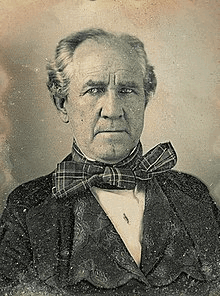 Sam Houston, c. 1850 | |
| In office December 21, 1859 – March 16, 1861 | |
| Lieutenant | Edward Clark |
| Preceded by | Hardin Richard Runnels |
| Succeeded by | Edward Clark |
| In office February 21, 1846 – March 3, 1859 | |
| Preceded by | Seat established |
| Succeeded by | John Hemphill |
| In office December 21, 1841 – December 9, 1844 | |
| Vice President | Edward Burleson |
| Preceded by | Mirabeau B. Lamar |
| Succeeded by | Anson Jones |
| In office October 22, 1836 – December 10, 1838 | |
| Vice President | Mirabeau B. Lamar |
| Preceded by | David G. Burnet (ad interim) |
| Succeeded by | Mirabeau B. Lamar |
| In office 1839–1841 | |
| In office October 1, 1827 – April 16, 1829 | |
| Lieutenant | William Hall |
| Preceded by | William Carroll |
| Succeeded by | William Hall |
| In office March 4, 1823 – March 3, 1827 | |
| Preceded by | Constituency established |
| Succeeded by | John Bell |
| Born | Samuel Houston March 2, 1793Rockbridge County, Virginia, U.S. |
| Died | July 26, 1863 (aged 70) Huntsville, Texas, C.S. |
| Resting place | Oakwood Cemetery Huntsville, Texas, U.S. |
| Political party | Democratic-Republican (before 1830) Democratic (1846–1854) Know Nothing (1855–1856) Independent (after 1856) |
| Spouse(s) | Eliza Allen Tiana Rogers Margaret Lea (m. 1840) |
| Signature | |
| Allegiance | United States of America Republic of Texas |
| Branch/service | United States Army Texan Army |
| Years of service | U.S. Army: 1813–1818 Texan Army: 1835–1836 |
| Rank | U.S. Army: First lieutenant Texan Army: Major general |
| Unit | U.S. Army: 39th Infantry Regiment |
| Commands | Texan Army: Army of the Republic of Texas |
| Battles/wars | |
Samuel Houston (March 2, 1793 – July 26, 1863) was an American soldier and politician. An important leader of the Texas Revolution, Houston served as the first and third president of the Republic of Texas, and was one of the first two individuals to represent Texas in the United States Senate. He also served as the sixth governor of Tennessee and the seventh governor of Texas, the only American to be elected governor of two different states in the United States.
Born in Rockbridge County, Virginia, Houston and his family migrated to Maryville, Tennessee, when Houston was a teenager. Houston later ran away from home and spent about three years with the Cherokee[1], becoming known as Raven. He served under General Andrew Jackson in the War of 1812, and after the war, he presided over the removal of many Cherokee from Tennessee. With the support of Jackson and others, Houston won election to the United States House of Representatives in 1823. He strongly supported Jackson's presidential candidacies, and in 1827, Houston was elected as the governor of Tennessee. In 1829, after divorcing his first wife, Houston resigned from office, and joined his Cherokee friends in Arkansas Territory.
Houston settled in Texas in 1832. After the Battle of Gonzales, Houston helped organize Texas's provisional government and was selected as the top-ranking official in the Texian Army. He led the Texian Army to victory at the Battle of San Jacinto, the decisive battle in Texas's war for independence against Mexico. After the war, Houston won election in the 1836 Texas presidential election. He left office due to term limits in 1838 but won election to another term in the 1841 Texas presidential election. Houston played a key role in the annexation of Texas by the United States in 1845, and in 1846, he was elected to represent Texas in the United States Senate. He joined the Democratic Party and supported President James K. Polk's prosecution of the Mexican–American War.
Houston's senate record was marked by his unionism and opposition to extremists from both the North and South. He voted for the Compromise of 1850, which settled many of the territorial issues left over from the Mexican–American War and the annexation of Texas. He later voted against the Kansas–Nebraska Act because he believed it would lead to increased sectional tensions over slavery, and his opposition to that act led him to leave the Democratic Party. He was an unsuccessful candidate for the presidential nomination of the American Party in the 1856 presidential election and the Constitutional Union Party in the 1860 presidential election. In 1859, Houston won election as the governor of Texas. In this role, he opposed secession and unsuccessfully sought to keep Texas out of the Confederate States of America. He was forced out of office in 1861 and died in 1863. Houston's name has been honored in numerous ways, and he is the eponym of the city of Houston, the fourth most populous city in the United States.
Contents
- 1Early life
- 2War of 1812 and aftermath
- 3Early political career
- 4Political exile and controversy
- 5Texas Revolution
- 6President of Texas
- 7U.S. Senator
- 8Governor of Texas
- 9Retirement and death
- 10Personal life
- 11Legacy
- 12See also
- 13Notes
- 14References
- 15Bibliography
- 16External links
Early life[edit]
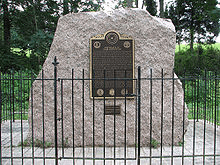 Sam Houston Birthplace Marker in Rockbridge County, Virginia
Sam Houston Birthplace Marker in Rockbridge County, VirginiaHouston was born in Rockbridge County, Virginia, on March 2, 1793, to Samuel Houston and Elizabeth Paxton. Both of Houston's parents were descended from Scottish and Irish immigrants who had settled in British North America in the 1730s.[2] Houston's father was descended from Ulster Scots people; he could trace his ancestry to Sir Hugh de Paduinan, a Norman knight.[3] By 1793, the elder Samuel Houston owned a large farm and slaves and served as a colonel in the Virginia militia.
Houston's uncle, the Presbyterian Rev. Samuel Houston, was an elected member of the "lost" State of Franklin then in the western frontier of North Carolina, who advocated for the passage of his proposed "A Declaration of Rights or Form of Government on the Constitution of the Commonwealth of Frankland" at the convention that was assembled in Greeneville, Tennessee on November 14, 1785. Rev. Houston returned to Rockbridge County, Virginia after the assembled State of Franklin convention rejected his constitutional proposal.[4]
Houston had five brothers and three sisters as well as dozens of cousins who lived in the surrounding area. According to biographer John Hoyt Williams, Houston was not close with his siblings or his parents, and he rarely spoke of them in his later life.[2] Houston did take an interest in his father's library, reading works by classical authors like Virgil as well as more recent works by authors such as Jedidiah Morse.[5]
Houston's father was not a good manager and got into debt, in part because of his militia service.[6] He planned to sell the farm and move west to Tennessee, where land was less expensive, but he died in 1806. Houston's mother followed through on those plans and settled the family near Maryville, Tennessee, the seat of Blount County, Tennessee. At this time, Tennessee was on the American frontier, and even larger towns like Nashville were vigilant against Native American raids. Houston disliked farming and working in the family store, and at the age of 16, he left his family to live with a Cherokee tribe led by Ahuludegi (also spelled Oolooteka).[7][8] Houston formed a close relationship with Ahuludegi and learned the Cherokee language, becoming known as Raven.[9] He left the tribe to return to Maryville in 1812, and he was hired at age 19 for a term as the schoolmaster of a one-room schoolhouse.[10]
War of 1812 and aftermath[edit]
In 1812, Houston enlisted in the United States Army, which then was engaged in the War of 1812 against Britain and Britain's Native American allies.[11] He quickly impressed the commander of the 39th Infantry Regiment, Thomas Hart Benton, and by the end of 1813, Houston had risen to the rank of the third lieutenant. In early 1814, the 39th Infantry Regiment became a part of the force commanded by General Andrew Jackson, who was charged with putting an end to raids by a faction of the Muscogee (or "Creek") tribe in the Old Southwest.[12] Houston was wounded badly in the Battle of Horseshoe Bend, the decisive battle in the Creek War. Although army doctors expected him to die of his wounds, Houston survived and convalesced in Maryville and other locations. While many other officers lost their positions after the end of the War of 1812 due to military cutbacks, Houston retained his commission with the help of Congressman John Rhea.[13] During that time he was promoted to the rank of second lieutenant.[8]
In early 1817, Houston was assigned to a clerical position in Nashville, serving under the adjutant general for the army's Southern Division. Later in the year, Jackson appointed Houston as a sub-agent to handle the removal of Cherokee from East Tennessee.[14] In February 1818, he received a strong reprimand from Secretary of War John C. Calhoun after he wore Native American dress to a meeting between Calhoun and Cherokee leaders, beginning an enmity that lasted until Calhoun's death in 1850.[15] Angry over the incident with Calhoun and an investigation into his activities, Houston resigned from the army in 1818. He continued to act as a government liaison with the Cherokee, and in 1818, he helped some of the Cherokee resettle in Arkansas Territory.[16]
Early political career[edit]
After leaving government service, Houston began an apprenticeship with Judge James Trimble in Nashville. He quickly won admission to the state bar and opened a legal practice in Lebanon, Tennessee. With the aid of Governor Joseph McMinn, Houston won election as the district attorney for Nashville in 1819. He was also appointed as a major general of the Tennessee militia.[8][17] Like his mentors, Houston was a member of the Democratic-Republican Party, which dominated state and national politics in the decade following the War of 1812.[citation needed] Tennessee gained three seats in the United States House of Representatives after the 1820 United States Census, and, with the support of Jackson and McMinn, Houston ran unopposed in the 1823 election for Tennessee's 9th congressional district.[18] In his first major speech in Congress, Houston advocated for the recognition of Greece, which was fighting a war of independence against the Ottoman Empire.[19]
Houston strongly supported Jackson's candidacy in the 1824 presidential election, which saw four major candidates, all from the Democratic-Republican Party, run for president. As no candidate won a majority of the vote, the House of Representatives held a contingent election, which was won by John Quincy Adams.[20] Supporters of Jackson eventually coalesced into the Democratic Party, and those who favored Adams became known as National Republicans. With Jackson's backing, Houston won election as governor of Tennessee in 1827.[21] Governor Houston advocated the construction of internal improvements such as canals, and sought to lower the price of land for homesteaders living on public domain. He also aided Jackson's successful campaign in the 1828 presidential election.[22]
In January 1829, Houston married Eliza Allen, the daughter of wealthy plantation owner John Allen of Gallatin, Tennessee. The marriage quickly fell apart possibly because Eliza loved another man.[23] In April 1829, following the collapse of his marriage, Houston resigned as governor of Tennessee. Shortly after leaving office, he traveled to Arkansas Territory to rejoin the Cherokee.[24]
Political exile and controversy[edit]
Houston was reunited with Ahuludegi's group of Cherokee in mid-1829.[25] Because of Houston's experience in government and his connections with President Jackson, several local Native American tribes asked Houston to mediate disputes and communicate their needs to the Jackson administration.[26] In late 1829, the Cherokee accorded Houston tribal membership and dispatched him to Washington to negotiate several issues.[27] In anticipation of the removal of the remaining Cherokee east of the Mississippi River, Houston made an unsuccessful bid to supply rations to the Native Americans during their journey.[28] When Houston returned to Washington in 1832, Congressman William Stanbery alleged that Houston had placed a fraudulent bid in 1830 in collusion with the Jackson administration. On April 13, 1832, after Stanbery refused to answer Houston's letters regarding the incident, Houston beat Stanbery with a cane.[29] After the beating, the House of Representatives brought Houston to trial. By a vote of 106 to 89, the House convicted Houston, and Speaker of the House Andrew Stevenson formally reprimanded Houston.[8] A federal court also required Houston to pay $500 in damages.
Texas Revolution[edit]
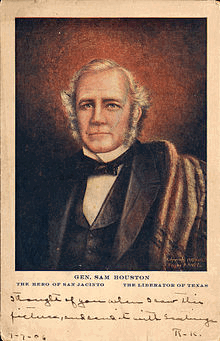 General Sam Houston (postcard, circa 1905)
General Sam Houston (postcard, circa 1905)In mid-1832, Houston's friends, William H. Wharton and John Austin Wharton, wrote to convince him to travel to the Mexican possession of Texas, where unrest among the American settlers was growing.[30] The Mexican government had invited Americans to settle the sparsely populated region of Texas, but many of the settlers, including the Whartons, disliked Mexican rule. Houston crossed into Texas in December 1832, and shortly thereafter, he was granted land in Texas.[31] Houston was elected to represent Nacogdoches, Texas at the Convention of 1833, which was called to petition Mexico for statehood (at the time, Texas was part of the state of Coahuila y Tejas). Houston strongly supported statehood, and he chaired a committee that drew a proposed state constitution.[32] After the convention, Texan leader Stephen F. Austin petitioned the Mexican government for statehood, but he was unable to come to an agreement with President Valentín Gómez Farías. In 1834, Antonio López de Santa Anna assumed the presidency, took on new powers, and arrested Austin.[33] In October 1835, the Texas Revolution broke out with the Battle of Gonzales, a skirmish between Texan forces and the Mexican Army. Shortly after the battle, Houston was elected to the Consultation, a congregation of Texas leaders.[34]
Along with Austin and others, Houston helped organize the Consultation into a provisional government for Texas. In November, Houston joined with most other delegates in voting for a measure that demanded Texas statehood and the restoration of the 1824 Constitution of Mexico. The Consultation appointed Houston as a major general and the highest-ranking officer of the Texian Army,[8][11] though the appointment did not give him effective control of the militia units that constituted the Texian Army.[35] Houston helped organize the Convention of 1836, where the Republic of Texas declared independence from Mexico, and appointed him as Commander-in-Chief of the Texas Army. Shortly after the declaration, the convention received a plea for assistance from William B. Travis, who commanded Texan forces under siege by Santa Anna at the Alamo. The convention confirmed Houston's command of the Texian Army and dispatched him to lead a relief of Travis's force, but the Alamo fell before Houston could organize his forces at Gonzales, Texas. Seeking to intimidate Texan forces into surrender, the Mexican army killed every defender at the Alamo; news of the defeat outraged many Texans and caused desertions in Houston's ranks.[36] Commanding a force of about 350 men that numerically was inferior to that of Santa Anna, Houston retreated east across the Colorado River.[37]
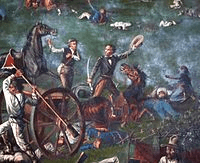 Detail from Houston at the Battle of San Jacinto by Henry Arthur McArdle
Detail from Houston at the Battle of San Jacinto by Henry Arthur McArdle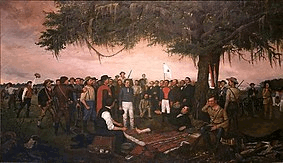
Though the provisional government, as well as many of his own subordinates, urged him to attack the Mexican army, Houston continued the retreat east, informing his soldiers that they constituted "the only army in Texas now present ... There are but a few of us, and if we are beaten, the fate of Texas is sealed."[38][a] Santa Anna divided his forces and finally caught up to Houston in mid-April 1836.[40] Santa Anna's force of about 1,350 soldiers trapped Houston's force of 783 men in a marsh; rather than pressing the attack, Santa Anna ordered his soldiers to make camp. On the April 21, Houston ordered an attack on the Mexican army, beginning the Battle of San Jacinto. The Texans quickly routed Santa Anna's force, though Houston's horse was shot out under him and his ankle was shattered by a stray bullet.[8][41] In the aftermath of the Battle of San Jacinto, a detachment of Texans captured Santa Anna.[42] Santa Anna was forced to sign the Treaty of Velasco, granting Texas its independence. Houston stayed briefly for negotiations, then returned to the United States for treatment of his ankle wound.[citation needed]
President of Texas[edit]
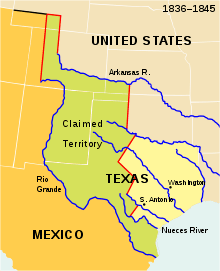 The Republic of Texas after the Texas Revolution
The Republic of Texas after the Texas RevolutionVictory in the Battle of San Jacinto made Houston a hero to many Texans, and he won the 1836 Texas presidential election, defeating Stephen F. Austin and former governor Henry Smith. Houston took office on October 22, 1836 after interim president David G. Burnet resigned.[43] During the presidential election, the voters of Texas overwhelmingly indicated their desire for Texas to be annexed by the United States. Houston, meanwhile, faced the challenge of assembling a new government, putting the country's finances in order, and handling relations with Mexico. He selected Thomas Jefferson Rusk as secretary of war, Smith as secretary of the treasury, Samuel Rhoads Fisher as secretary of the navy, James Collinsworth as attorney general, and Austin as secretary of state.[44][b] Houston sought normalized relations with Mexico, and despite some resistance from the legislature, arranged the release of Santa Anna.[46] Concerned about upsetting the balance between slave states and free states, U.S. President Andrew Jackson refused to push for the annexation of Texas, but in his last official act in office he granted Texas diplomatic recognition.[47] With the United States unwilling to annex Texas, Houston began courting British support; as part of this effort, he urged the end of the importation of slaves into Texas.[48]
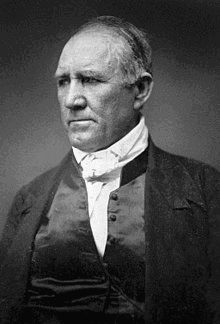 Sam Houston
Sam HoustonIn early 1837, the government moved to a new capital, the city of Houston, named for the country's first president.[49] In 1838, Houston frequently clashed with Congress over issues such as a treaty with the Cherokee and a land-office act[50] and was forced to put down the Córdova Rebellion, a plot to allow Mexico to reclaim Texas with aid from the Kickapoo Indians.[8] The Texas constitution barred presidents from seeking a second term, so Houston did not stand for re-election in the 1838 election and left office in late 1838. He was succeeded by Mirabeau B. Lamar, who, along with Burnet, led a faction of Texas politicians opposed to Houston.[51] The Lamar administration removed many of Houston's appointees, launched a war against the Cherokee, and established a new capital at Austin, Texas.[52] Meanwhile, Houston opened a legal practice and co-founded a land company with the intent of developing the town of Sabine City.[53] In 1839, he was elected to represent San Augustine County in the Texas House of Representatives.[54]
Houston defeated Burnet in the 1841 Texas presidential election, winning a large majority of the vote.[55] Houston appointed Anson Jones as secretary of state, Asa Brigham as secretary of the treasury, George Washington Hockley as secretary of war, and George Whitfield Terrell as attorney general.[56] The republic faced a difficult financial situation; at one point, Houston commandeered an American brig used to transport Texas soldiers because the government could not afford to pay the brig's captain.[57] The Santa Fe Expedition and other initiatives pursued by Lamar had stirred tensions with Mexico, and rumors frequently raised fears that Santa Anna would launch an invasion of Texas.[58] Houston continued to curry favor with Britain and France, partly in the hope that British and French influence in Texas would encourage the United States to annex Texas.[59] The Tyler administration made the annexation of Texas its chief foreign policy priority, and in April 1844, Texas and the United States signed an annexation treaty. Annexation did not have sufficient support in Congress, and the United States Senate rejected the treaty in June.[60]
Henry Clay and Martin Van Buren, the respective front-runners for the Whig and Democratic nominations in the 1844 presidential election, both opposed the annexation of Texas. However, Van Buren's opposition to annexation damaged his candidacy, and he was defeated by James K. Polk, an acolyte of Jackson and an old friend of Houston, at the 1844 Democratic National Convention. Polk defeated Clay in the general election, giving backers of annexation an electoral mandate. Meanwhile, Houston's term ended in December 1844, and he was succeeded by Anson Jones, his secretary of state. In the waning days of his own presidency, Tyler used Polk's victory to convince Congress to approve of the annexation of Texas. Seeking Texas's immediate acceptance of annexation, Tyler made Texas a generous offer that allowed the state to retain control of its public lands, though it would be required to keep its public debt.[61] A Texas convention approved of the offer of annexation in July 1845, and Texas officially became the 28th U.S. state on December 29, 1845.[62]

